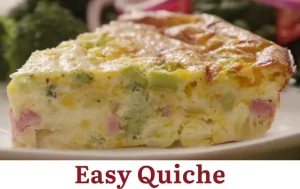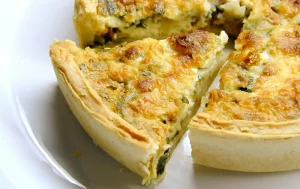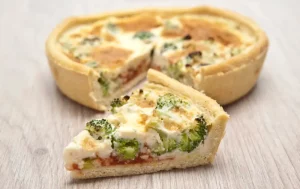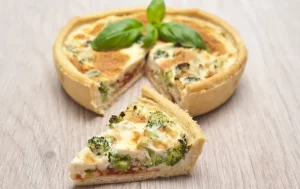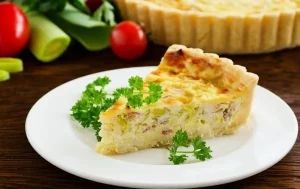Quiche, a versatile and beloved dish, combines a flaky pastry crust with a savory custard filling, often enriched with various combinations of meats, cheeses, vegetables, and herbs. Originating from Germany, quiche became immensely popular in France and has since found its way into kitchens around the globe, celebrated for its elegant simplicity and delicious taste.
Selecting the Right Ingredients
The secret to a great quiche starts with high-quality ingredients. For the crust, a basic dough of flour, butter, and water is essential for achieving that perfect, buttery flakiness. Some prefer to add a pinch of salt or sugar to enhance the flavor. As for the filling, the choices are endless. Eggs and cream form the custard base, to which you can add grated cheese (Swiss, cheddar, or Gruyère are popular choices), diced vegetables (like spinach, mushrooms, or bell peppers), and proteins (such as bacon, ham, or smoked salmon).
Preparing the Perfect Crust
Preparing the crust involves cutting cold butter into the flour until the mixture resembles coarse crumbs, then adding ice water to bring the dough together. Chilling the dough before rolling it out and fitting it into a pie dish helps prevent shrinkage during baking. For an extra crispy base, blind baking the crust before adding the filling is a recommended step.
Crafting the Custard Filling
The custard filling is what truly sets a quiche apart. Whisking together eggs and cream with a dash of salt and pepper creates a smooth, pourable mixture. This is the stage where creativity shines, as you can incorporate any combination of fillings to suit your taste. Layering the ingredients in the pre-baked crust before pouring over the egg mixture ensures an even distribution of flavors.
Baking to Perfection
Baking the quiche requires a careful balance of temperature and time. A moderate oven, preheated to about 375°F (190°C), allows the custard to set without overcooking. The quiche is done when the filling is just set and the top is lightly golden, which usually takes around 35 to 45 minutes. Letting the quiche rest for a few minutes before cutting allows the filling to firm up, making it easier to slice.
Customizing Your Quiche
One of the joys of quiche is its adaptability. Vegetarians can opt for a meat-free version filled with seasonal vegetables and herbs, while those looking for a lighter option can use milk instead of cream for the custard. Experimenting with different cheese varieties and herbs can also bring new dimensions of flavor to the dish.
Serving Suggestions
Quiche can be served hot, warm, or even at room temperature, making it a flexible option for any meal. It pairs wonderfully with a simple green salad for a light lunch or dinner, or it can be served as part of a brunch spread, complementing fruit, muffins, and other breakfast fare.
The Social Aspect of Quiche
Beyond its culinary appeal, quiche has a way of bringing people together. It’s a popular choice for gatherings, potlucks, and special occasions, offering a sophisticated yet comforting dish that’s as pleasing to the eye as it is to the palate. Sharing a homemade quiche with friends and family not only feeds the body but also the soul, making it a dish that’s cherished far beyond its basic ingredients.
In exploring the art of quiche-making, cooks discover not just the technique behind this classic dish but also the endless possibilities it offers for creative expression in the kitchen. Whether sticking to traditional recipes or venturing into new flavor territories, the journey to perfecting quiche is one filled with delicious rewards and culinary discovery.
Embracing Seasonal Ingredients
Quiche invites the opportunity to embrace seasonal ingredients, making each version a reflection of the time of year. Spring quiches burst with asparagus, leeks, and fresh peas, while summer versions might feature zucchini, tomato, and basil for a taste of the garden. Autumn and winter quiches can become heartier, incorporating roasted root vegetables, kale, or pumpkin, paired with robust cheeses and meats.
The Importance of Texture and Consistency
Achieving the right texture and consistency in both the crust and filling is paramount. The crust should be flaky and tender, offering a delightful contrast to the creamy, rich filling. To ensure the custard sets properly without becoming rubbery, avoid overbaking. The custard should have a slight jiggle in the center when removed from the oven; it will continue to set as it cools.
Nutritional Adaptations
For those mindful of nutrition, quiche offers flexibility. Substituting half-and-half or whole milk for the cream reduces fat without sacrificing the creamy texture. Incorporating whole wheat flour in the crust or increasing the ratio of vegetables to meat can boost fiber content and nutritional value. Egg whites can replace some or all of the whole eggs to lower cholesterol.
Flavor Combinations to Explore
The potential flavor combinations in quiche are endless, allowing for constant experimentation. Try combinations like goat cheese with spinach and sun-dried tomatoes; or caramelized onions, Gruyère, and thyme for a classic French feel. Smoked salmon, dill, and capers offer a nod to Scandinavian tastes. Each variation brings its unique flair to the quiche, making it a canvas for culinary creativity.
Tips for a Successful Quiche
- Prepping Ahead: The crust and even the entire quiche can be made ahead of time, making it a convenient option for entertaining or meal prepping.
- Resting Time: Allowing the quiche to rest after baking is crucial for the filling to set, ensuring clean slices.
- Blind Baking: To prevent a soggy bottom, blind bake the crust with pie weights or dried beans before adding the filling.
Quiche as a Canvas for Leftovers
Quiche excels as a delicious way to repurpose leftovers. Almost any leftover vegetables or cooked meats can find a new life in a quiche, reducing food waste while creating a meal that feels entirely new and intentional.
Celebrating Diversity in Quiche
The quiche’s adaptability to different cuisines is a testament to its global appeal. Incorporating spices and ingredients from various cultures, such as curry spices for an Indian-inspired quiche or chorizo and jalapeños for a Mexican twist, showcases the versatility of this dish.
Quiche for Every Occasion
Whether it’s a casual family dinner, a sophisticated brunch, or a picnic, quiche fits the bill. Its ability to be served at various temperatures and its ease of transport make it suitable for almost any setting, ensuring that this classic dish remains a beloved choice for cooks and diners alike.
Through the exploration of quiche, cooks not only hone their culinary skills but also unlock a world of flavors, textures, and traditions. Quiche stands as a celebration of simplicity and sophistication, a dish that continues to inspire and bring joy with each new variation.
Mastering the Art of Quiche Variations
Exploring quiche variations becomes an adventure in culinary creativity. Introducing smoked salmon and dill offers an elegant twist, perfect for brunches or light dinners. Alternatively, combining chorizo with roasted red peppers and a touch of smoked paprika creates a quiche with a Spanish influence, rich in color and smoky flavors.
The Joy of Seasonal Ingredients
Utilizing seasonal ingredients not only supports local agriculture but also ensures the freshest flavors make their way into your quiche. A summer quiche might feature heirloom tomatoes and fresh corn, while a winter version could highlight roasted butternut squash and sage. Each season brings its own palette of flavors to play with.
Global Inspirations for Your Quiche
Drawing inspiration from global cuisines can transform your quiche into a world tour of flavors. Consider a Greek-inspired quiche with spinach, feta, and olives, or venture into Asian territories with a quiche featuring shiitake mushrooms, scallions, and a splash of soy sauce. These global variations showcase the adaptability of quiche to different taste profiles.
Perfecting the Presentation
Presentation enhances the overall quiche experience. A golden-brown crust, visibly layered fillings, and a garnish of fresh herbs not only make the quiche visually appealing but also invite anticipation for the first bite. Experiment with lattice patterns or decorative edges for the crust to add an artistic touch.
Quiche as a Meal Prep Solution
Quiche’s suitability for meal prep cannot be overstated. It reheats well, making it a convenient option for breakfasts, lunches, or dinners throughout the week. Individual slices can be frozen and reheated, ensuring a homemade meal is always just minutes away.
Inclusive Quiche Making
Making quiche inclusive means adapting recipes to suit all dietary preferences. Gluten-free crust options, dairy substitutes, and an array of vegetable-based fillings ensure that everyone can enjoy a slice. Experimenting with vegan egg alternatives like tofu for the custard base opens up quiche to even more diners.
Sharing the Experience
Inviting friends and family to join in the quiche-making process turns cooking into a communal activity. Not only does it allow for the sharing of techniques and recipes, but it also creates memories centered around the joy of cooking and eating together.
Quiche stands as a testament to the joys of cooking, offering endless possibilities for customization, adaptation, and exploration. Its ability to unite traditional and innovative elements, cater to various dietary needs, and serve as a canvas for seasonal and global flavors makes quiche a perennial favorite in the culinary world. Whether as a vehicle for showcasing local produce, a means of exploring international cuisines, or simply as a comforting meal, quiche continues to inspire and delight with its versatility and depth of flavor.
FAQs about Quiche
Can I make quiche without a crust for a low-carb option?
Yes, you can make a crustless quiche by simply pouring the egg mixture directly into a well-greased pie dish and baking. This version is great for those following a low-carb or gluten-free diet.
How do I prevent my quiche from becoming soggy?
To prevent a soggy quiche, blind bake your crust before adding the filling. This process involves baking the crust partially, which helps it become crisp and golden. Also, ensure your fillings, especially vegetables, are not too watery.
Can quiche be made ahead of time and frozen?
Absolutely! Bake the quiche, allow it to cool, then wrap it tightly before freezing. Reheat in the oven for a quick and delicious meal. This makes quiche an excellent option for meal prep or unexpected guests.
Is it possible to make a dairy-free quiche?
Yes, for a dairy-free quiche, substitute the cream with a plant-based alternative such as almond or coconut milk, and use dairy-free cheese or simply omit the cheese.
What are some unique quiche flavor combinations?
Get creative with combinations like roasted beet and goat cheese, pear and gorgonzola, or turkey and cranberry for a festive twist. Exploring different cuisines can also inspire unique quiches, such as a Mexican quiche with black beans and corn or an Italian version with sun-dried tomatoes and basil.
Conclusion
Quiche is a versatile and beloved dish that stands as a testament to the creativity and adaptability of cooks everywhere. Whether you’re crafting a classic Lorraine or experimenting with bold, international flavors, quiche offers a canvas for culinary expression. It accommodates a vast array of ingredients, making it suitable for any meal and diet preference. From its flaky crust to its rich, savory custard, quiche is a celebration of texture and taste. Beyond its deliciousness, quiche embodies the joy of sharing food, bringing people together over a meal that’s both comforting and sophisticated. As you master the art of quiche, let your kitchen be a place of exploration and your table a place of gathering, savoring each bite of this timeless dish.
Print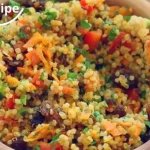
Quiche
- Author: recipstep
- Total Time: 1 hour 15 minutes
- Yield: 8 servings 1x
- Diet: Vegetarian
Description
Quiche is a savory pie filled with a mixture of eggs, cream, cheese, and various fillings like vegetables, meats, and herbs, encased in a buttery pastry crust. It’s a versatile dish that can be served for breakfast, brunch, lunch, or dinner.
Ingredients
2 cups milk
4 large eggs
1 cup grated Parmesan cheese
3/4 cup biscuit baking mix
1/4 cup butter, softened
1 (10-ounce) package chopped frozen broccoli, thawed and drained
8 ounces shredded Cheddar cheese
1 cup cubed cooked ham
Instructions
Preheat Oven :
Preheat the oven to 375 degrees F (190 degrees C). Lightly grease a 10-inch quiche dish.
Prepare Batter :
Beat milk, eggs, Parmesan cheese, baking mix, and softened butter in a large bowl until well combined; batter will be lumpy.
Add Ingredients :
Stir in thawed and drained broccoli, shredded Cheddar cheese, and cubed cooked ham.
Pour into Quiche Dish :
Pour the mixture into the prepared quiche dish.
Bake :
Bake in the preheated oven until eggs are set and the top is golden brown, about 50 minutes.
Enjoy! :
Slice and enjoy your delicious homemade quiche!
Serve it warm and savor the delightful flavors!
Notes
- Customize the filling based on preferences or what you have on hand.
- For a lighter version, substitute half of the cream with milk.
- A pre-made pie crust can be used for convenience.
- Prep Time: 20 minutes
- Cook Time: 55 minutes
- Category: Main Dish
- Method: Baking
- Cuisine: French
Nutrition
- Calories: 350 kcal
- Sugar: 1 g
- Sodium: 300 mg
- Fat: 29 g
- Saturated Fat: 17 g
- Carbohydrates: 12 g
- Fiber: 0.5 g
- Protein: 9 g
- Cholesterol: 215 mg


